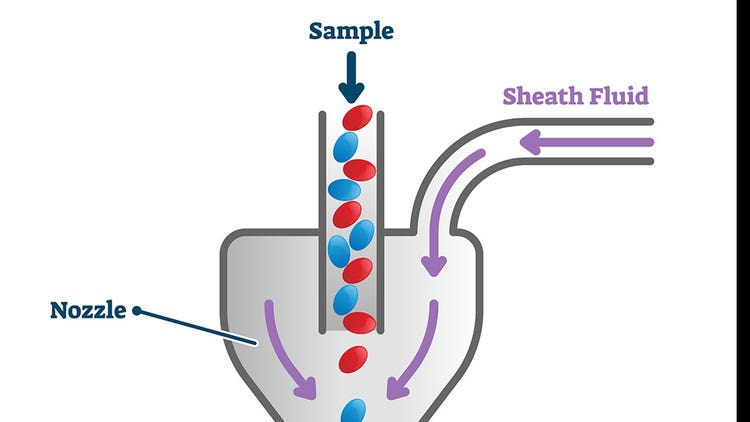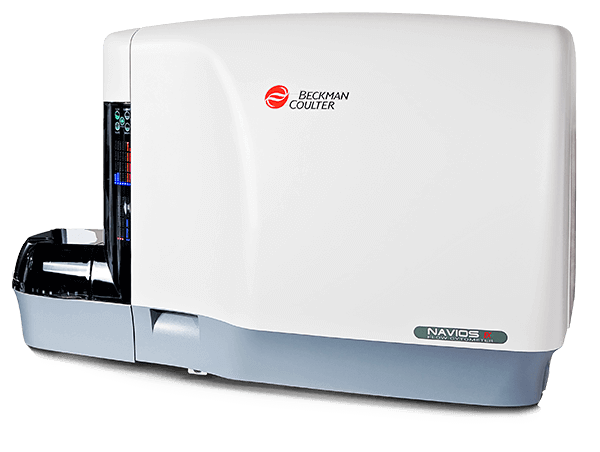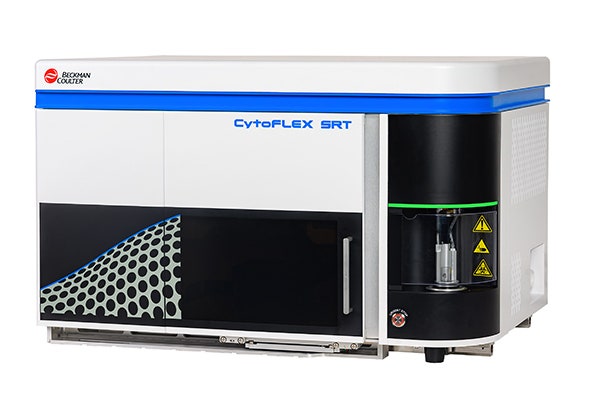What is Flow Cytometry?
Flow cytometry is a laser-based analytical technique used to measure and analyze multiple phenotypic characteristics of single cells as they flow through a laser beam in a fluid stream.
During the assay, cell components like surface proteins are labeled using fluorescent tags usually attached to antibodies. When the fluorescently tagged cells pass through the laser beam, they emit light of different wavelengths, which is caught by the detector present near the beam. The fluorescence and light scattering profile of individual cells can be used to study their identity.
Characteristics or properties of cells commonly analyzed using flow cytometry include cell size, cell volume, cell viability and cell cycle.
In 1950, the technique was first employed to measure the volume of cells in a sample. However, now it is widely used for a myriad of purposes in biotechnology and pharma labs, such as cell sorting, assessing the purity of a cell population, verifying the monoclonality of a cell line and analyzing protein abundance.
In this article, you will learn further about the flow cytometry principles, instrumentation, applications and advancements in technology.

Principles of Flow Cytometry
Flow cytometry is a perfect assay for the qualitative and quantitative analysis of the properties of individual cells. Flow cytometry runs on the principles of light scattering, excitation and emission. Fluorescently tagged cell components get excited when they pass through a laser beam, producing lights of different wavelengths. The fluorescence is used to analyze cellular properties.
Cells are analyzed by the following parameters:
- Visible light scatter: The forward scatter helps measure the size in the forward direction. The side scatter at 90 degrees measures the granularity and complexity of a cell.
- Fluorescence: Cells can emit fluorescence from dyes, such as propidium iodide, reporter genes fused to fluorescent proteins like GFP, or fluorescently conjugated antibodies.
See how Danaher Life Sciences can help
Flow Cytometry Instruments
Components of Flow Cytometers
The flow cytometer is comprised of three major components:
-
Fluidics system: The system consists of sheath fluid and a laminar flow that narrows down the specimen core for the movement of cells in a single stream when they pass through the laser beam.
-
Optical system: The optical system is composed of a laser, lenses, and collection optics (such as photomultiplier tubes (PMTs), involved in illuminating the sample stream passing through the laser and measuring the scattered light by each cell.
-
Electronics and data acquisition system: It includes photodetectors that convert laser beam voltages, giving readings/data to be processed and analyzed using computer software.
Types of Flow Cytometers
-
Traditional Flow Cytometers: These cytometers channel the cells through a stream of sheath fluid where they traverse beams from lasers that provide light scattering or fluorescence spectrum information.
-
Acoustic Focusing Cytometers: These cytometers use ultrasonic waves to direct a stream of cells to the laser beam for further analysis. It minimizes sample clogging that’s observed with some other cytometers.
-
Cell Sorters: It is a specialized flow cytometer that sorts and collects individual cells based on desired parameters such as absence or presence of certain phenotypic markers. The cell samples are deposited into wells on a plate or collected in tubes. Cell sorters can facilitate simple 2-way sorts (positive/negative) or multi-parameter sorts that allow users to combine desired parameters.
-
Flow Cytometry Imagers: This is a spin on traditional flow cytometers used to analyze single cells for multiple fluorescence parameters but also includes an imaging component that takes photos of the cells as they pass through the imaging area. It can provide subcellular localization information of the fluorescent probes.
Featured Flow Cytometer Product
Flow Cytometry - Principles, Types & Applications


Navios EX Flow Cytometers
Powerful, Dependable Flow Cytometer
Strong and stable cytometer performance is fundamental when analyzing important clinical samples as every event matters. Designed specifically for the clinical laboratory the NAVIOS EX 10-color flow cytometer delivers proven reliability and stability performance with improved sample traceability and reporting functions.

CytoFLEX SRT Benchtop Cell Sorters
CytoFLEX SRT Benchtop Cell Sorter Overview
CytoFLEX SRT Cell Sorter is a benchtop sorter. It is capable of meeting requirements for a wide range of sorting needs. And like the CytoFLEX Platform, it includes innovative technologies that simplify the setup and operation, empowering investigators to focus on the research questions. The Violet-Blue-Yellow Green-Red (V-B-Y-R) Series has 15 fluorescent detectors when fully activated.
Flow Cytometry Applications
Here are a few well-known applications of flow cytometry:
- Proteomics in early discovery - Flow cytometry is a great tool for proteomics in early discovery. Assays can assess dozens of cell surface or intracellular proteins simultaneously. The choice of antibodies can provide protein isoform information. Use of an imaging flow cytometer will elucidate subcellular location or trafficking.
- Immunophenotyping for cellular composition - In immunophenotyping, flow cytometry informs on the composition of a cell population based on lineage markers. This helps researchers uncover cellular heterogeneity and uncover rare cell populations that may be valuable for future study.
- Gene expression analysis in cell signaling pathways - Flow cytometry can highlight gene expression tied to important cell signaling pathways. Stimulated cells can be analyzed for up or down regulation of specific genes so researchers can hypothesize on regulatory mechanisms. This includes genes tied to the cell cycle phases.
- Disease diagnosis and monitoring in clinical labs - Disease diagnosis and monitoring can be conducted via flow cytometry in clinical labs. This is especially relevant for cancer and infectious disease where rapid testing is required. Flow cytometry assays can be qualified as an In Vitro Diagnostic (IVD) or validated as a Laboratory Developed Test (LDT).
Quality Control and Standardization in Flow Cytometry
Standardization and optimization of a flow cytometry assay is necessary to ensure valid and reproducible results. Some of the requirements for flow cytometry labs include:
Documentation of Steps
Sample preparation and starting sample quality can impact flow cytometry data integrity. It is important to properly document all steps to increase the likelihood of reproducibility.
Calibration and Performance Checks
Calibration and performance checks of the instrument, including tracking maintenance in logbooks, is a requirement for all labs but especially for clinical labs.
Reagent QC
Maintaining rigorous reagent QC is crucial to managing the inevitable lot-to-lot variability associated with flow cytometric analysis. Regular titration of antibodies is required to minimize occurrences of false positives.
Standardization Initiatives and Guidelines
These should be followed in labs. For instance, ISO 15189 accreditation is necessary in Europe for flow cytometry using labs in accordance with EU IVD-R 2017/746 Regulation.
Advanced Techniques and Emerging Trends in Flow Cytometry
With technological advancements, many innovative flow cytometry procedures have been developed for more efficient cell analysis.
-
Multicolor flow cytometry: The technique is also known as polychromatic cytometry. It analyzes the subpopulation of target cells based on multiple experimental parameters. In immunology, it’s used to detect specific populations of an immune cell at the single-cell level by combining a quantitative proteomics approach.
-
Full spectrum (spectral) flow cytometry: This technique captures the entire emitted spectrum of a fluorescent dye. It provides greater depth of information and provides benefits like reduced need for compensation, increased panel size and richer data sets.
-
Mass cytometry or cytometry by Time-of-Flight (CyTOF): This is a next-generation flow cytometry protocol and involves the use of metal-tagged antibodies for the morphological and functional analysis of single cells.
Considerations and Challenges in Flow Cytometry
Flow cytometry poses several challenges, including sample preparation that can lead to low cell viability and suboptimal cell counts during specimen evaluation. Other important considerations include cost associated with instrumentation, labor and training.
Reproducibility issues can also plague the flow cytometry field given variability in manual data analysis (gating) methods. Manual gating is prone to introduction of bias and can be subjective.
Employing flow cytometry for clinical testing requires labs and patients to consider reimbursement approvals and amounts.
Future Perspectives in Flow Cytometry
Flow cytometry is an essential technique in cell biology and life sciences labs. It’s a comprehensive technique for phenotypically analyzing cells. Thus, its use is poised to move towards newer applications such as exosome or extracellular vesicle research, ecological studies to identify microorganisms like bacteria, and marine research. Emphasis is being placed on reproducibility with automation for sample preparation.
The expansion of spectral cytometry and creation of new fluorescent dyes with novel emission patterns will continue to drive panel size increase. This will keep data analysis at the forefront and should drive adoption of automated gating strategies and software with AI/ML capabilities.
See how Danaher Life Sciences can help
FAQs
What is flow cytometry, and how does it work?
Flow cytometry is a comprehensive technology used in cell biology labs to analyze single cells on multiple parameters. The lasers in the device produce scattered and fluorescent light signals detected by photodetectors.
What are the applications of flow cytometry in biological research?
Flow cytometershave extensive applications in immunophenotyping, cell sorting, proteomics and cell cycle analysis. They are also used to identify and quantify a specific cell population from a mixture of different cell types.
What is the main advantage of flow cytometry?
Flow cytometry has multiple advantages:
- It can perform cell analysis on >40 parameters.
- It enables researchers to rapidly identify a specific cell population.
- FACS allows researchers to isolate populations of interest from a sample, facilitating subsequent in-depth analysis.
What is the difference between FACS and flow cytometry?
Flow cytometry is a comprehensive single cell analysis technique that can measure >40 parameters. FACS utilizes the flow cytometry principle to sort individual cells from a heterogenous cell sample. FACS is extensively used in sample preparation for a host of downstream research applications while flow cytometry is an end-point assay.